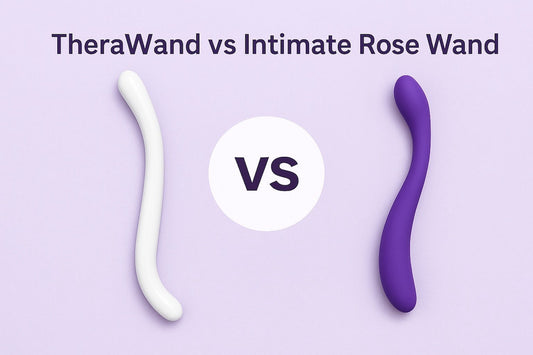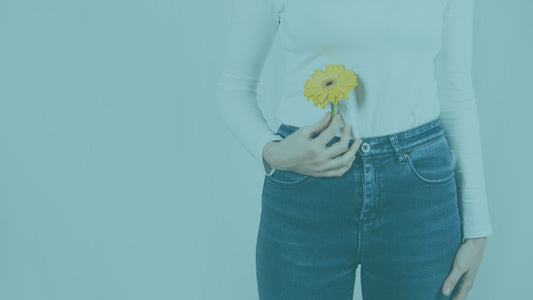Frequent urination is a symptom of urinary tract infection (UTI) and overactive bladder (OAB), making it difficult for some to determine which one they have. In fact, research shows that women with an OAB are often misdiagnosed as having a UTI and prescribed antibiotics that are pointless and ineffective.
Read on to learn the difference between an overactive bladder and a UTI, what causes both, how each is treated, and why UTIs are more common during menopause.
Overactive Bladder: What Causes It?
Involuntary bladder muscle contractions, specifically the detrusor muscle, cause OAB. When this muscle spontaneously contracts, or squeezes, the bladder initiates urination regardless of whether it is full.
This involuntary muscle contraction is usually triggered by something else. Such as tight pelvic floor muscles, drinking too much coffee, alcohol, citric fruit juices, or even too much water. For some, eating chocolate or spicy food can trigger detrusor overactivity and OAB.
Underlying conditions such as bladder stones, kidney stones, an enlarged prostate, cancer tumors, or poor kidney function can also trigger the detrusor muscles to contract spontaneously. Previous pelvic surgery or pelvic trauma may also lead to overactive bladder muscle contraction, as can stress, anxiety, and hormone fluctuations.
Similarly, diuretics and medication for other conditions can sometimes cause OAB.
What Are Overactive Bladder Symptoms?
The most obvious and uncomfortable symptom of an overactive bladder is the urgent need to urinate. It is often so strong that patients with OAB live with constant fear of urine leaks if they don't make it to the bathroom on time.
With OAB, this strong urge to pee happens at least 8 times per day, often more, and 2-3 times during the night. (Normal urination is typically 6-8 times daily and once at night, depending on age.)
Incontinence (urine leaks) and the frequent urge to pee can impact people's lives to the point that their relationships, sex life, willingness to socialize, and mental health are negatively affected.
OAB is persistent and considered a chronic condition that requires ongoing management.
What Causes Urinary Tract Infections?
Incorporating the bladder, kidneys, ureters, and urethra, the urinary tract is essentially the body's urinary system. The kidneys convert waste products from the blood into urine, which is then carried by the ureters to the bladder. After being temporarily stored in the bladder, urine is excreted from the body via the urethra.
UTIs are caused when an overgrowth of harmful bacteria, particularly E. coli, occurs anywhere in the urinary tract.
E. coli lives in the intestines and is often present in the skin around the anus. When it remains in these body parts, E. coli is harmless. However, when it comes in contact with open wounds, scratches, or the urinary tract, it can cause infection.
Women are 30 times more likely to experience UTIs than men because the urethra is located much closer to the anus. Wiping from back to front after the bathroom can spread E. coli to the urethra and develop into an infection that spreads through the urinary tract to the bladder, and sometimes the kidneys.
Having intercourse is also known to spread E. coli from the anal area to the urethra.
Urinary Tract Infection Symptoms
In contrast to OAB, which occurs over time and often with age, UTIs typically happen suddenly. The two most obvious symptoms of UTIs are the frequent urge to pee and a stinging or burning sensation while urinating. And rather than completely emptying the bladder, only small amounts of urine are passed during a UTI.
It's also common to feel pain in the abdomen, pelvic area, and/or lower back.
When a UTI occurs, urine can smell like fish or ammonia, appear cloudier, and sometimes turn pink. This is because irritation and inflammation of the urinary tract lining causes red blood cells to seep into the urine. Although blood in your urine can be alarming, this type is normally nothing to worry about and generally subsides with treatment.
Some women are known to experience extreme fatigue, confusion, chills, fever, nausea, and vomiting when UTIs occur, but these symptoms are less common.
What Are the Key Differences Between UTIs and Overactive Bladder?
The three key differences between UTIs and OAB are: timing, pain & urine color.
Timing
OAB tends to occur gradually, usually with age, as the bladder muscles weaken due to over contraction. UTIs on the other hand typically appear suddenly and are caused by an overgrowth of bacteria.
Pain
UTIs normally cause a stinging or burning feeling during urination, but this does happen with OAB. Pelvic and abdominal pain are also common with UTIs but not with OAB.
Urine Color
While bloody urine is a common symptom of UTIs, it is not usually caused by OAB.
Why Are UTIs More Common in Menopause?
UTIs are more common during perimenopause, menopause, and postmenopause due to lower estrogen levels.
In addition to supporting reproduction and menstruation, estrogen helps to maintain moisture and elasticity in the vaginal and urethral tissues. Estrogen also aids in producing natural vaginal lubrication and in sustaining friendly bacteria like lactobacilli in the vaginal microbiome, which help to fight any increase in harmful bacteria such as E. coli.
When estrogen production begins to decline with the onset of perimenopause, vaginal and urethral tissues typically lose moisture and elasticity, rendering them dryer, thinner, and weaker. The combination of vaginal dryness and a weaker urethra allow harmful bacteria like E. coli to enter the urinary tract more easily.
Because the friendly bacteria in the vaginal microbiome are no longer as plentiful due to low estrogen levels during menopause, harmful bacteria can thrive and urinary tract infections become more common.
Any vaginal, vulval, or urinary symptoms associated with low estrogen levels during menopause are considered part of the Genitourinary syndrome of menopause (GSM). In addition to UTIs, GSM, can involve vaginal dryness, vaginitis, vulvodynia, and pain during sex (dyspareunia).
How to Treat an Overactive Bladder
The first step in treating OAB is identifying the underlying cause. It can be helpful to start by eliminating triggering drinks or foods. If frequent urination stops, the next step would be to eliminate one at a time to identify the main culprit(s).
If eliminating OAB triggering foods and beverages doesn't make a difference, a full health check with a healthcare provider can determine if an underlying condition is causing an overactive bladder. If this is not the case, it's recommended to consult with a pelvic physical therapist to check the health of your pelvic floor muscles.
Weak pelvic floor muscles can often lead to urgency and urine incontinence, but can be easily rectified with Kegel exercises or the help of Kegel weights. If tight pelvic floor muscles are triggering muscle contractions in the bladder, pelvic massage wands can help release points of tension in the pelvic floor to relieve OAB. Vaginal dilators are also sometimes recommended to ease pelvic muscle tightness that could be contributing to involuntary bladder muscle contractions.
When pelvic floor issues are found to be the cause of OAB, hormone fluctuations may also be problematic, depending on your age. In this case, it's wise to consult with a menopause expert to determine if hormone therapy, pelvic health tools, or natural remedies can help.
In all cases of OAB, bladder training is typically suggested to retrain the bladder muscles. It involves following a set schedule for urinating and gradually increasing the time urine is held before peeing. Over time, the detrusor muscle can be retrained, just like any other muscle in the body, to behave normally rather than involuntarily contract.
How to Treat a Urinary Tract Infection
UTIs are treated with antibiotics and symptoms typically subside within 1-2 days, but it's vital to complete the course you are prescribed to clear the infection. While taking antibiotics, drink plenty of water to help flush the harmful bacteria.
To prevent UTIs, wipe from front to back after using the bathroom, reduce stress levels, and wash the genitals after sex with warm water and unscented soap.
If you're experiencing recurring UTIs, a daily probiotic (which are friendly bacteria) is suggested to maintain a healthy and balanced vaginal microbiome. Probiotics can be especially helpful for peri or post-menopausal women who often suffer from recurring UTIs due to low estrogen levels.
Another powerful supplement for preventing the recurrence of UTIs is Aloe Vera with D-Mannose and Calcium from pelvic health experts, Intimate Rose.
Aloe vera has been proven to reduce bladder pain, urinary frequency, urgency, and urethral burning by as much as 92%. The added calcium stabilizes vaginal pH levels for a balanced microbiome and D-mannose prevents harmful bacteria from sticking to the urinary tract.
Other Medical Conditions that Cause Frequent Urination
Although OAB and UTIs are the most common causes of a strong and frequent urge to urinate, it's important to rule out other underlying conditions that could be causing it.
If, for example, the frequent need to pee is accompanied by symptoms such as itchy skin, a dry mouth, increased hunger, thirst, fatigue, or blurred vision, schedule an appointment with your healthcare provider to rule out diabetes.
Individuals who have had a stroke, or have been diagnosed with spina bifida, spinal cord injuries, Parkinson's disease, multiple sclerosis, or other neurological disorders may also experience a strong and frequent urge to urinate.
This type of urge to pee is known as a neurogenic bladder. It is typically due to damaged bladder nerves, and it's best to consult a healthcare practitioner for treatment options.
Conclusion
Although an overactive bladder (OAB) and a urinary tract infection (UTI) have the frequent urge to pee in common, they are very different conditions. OAB is a persistent and long-term condition that develops gradually due to involuntary bladder muscle contractions. It involves an urgent need to urinate and bladder leaks are common, but no stinging or pain is experienced while peeing.
A UTI is an infection of the urinary tract caused by an overgrowth of harmful bacteria. The frequent urge to pee rarely results in urine leaks, but peeing typically occurs only a few drops at a time and is usually accompanied by a stinging pain.
UTIs are treated with antibiotics and clear up within a few days, but are known to recur more often during menopause due to low estrogen. OAB relief requires bladder training and case-by-case treatment depending on what has caused the muscle contractions.
References
Urology Care Foundation - Overactive Bladder (OAB) - https://www.urologyhealth.org/urology-a-z/o/overactive-bladder-(oab)
Web MD - Urinary Tract Infections - https://www.webmd.com/women/your-guide-urinary-tract-infections
National Library of Medicine - Urinary Tract Infection in Women - https://pmc.ncbi.nlm.nih.gov/articles/PMC8077804/#
American College of Obstetricians & Gynecologists - UTIs After Menopause: Why They're Common and What to Do About Them - https://www.acog.org/womens-health/experts-and-stories/the-latest/utis-after-menopause-why-theyre-common-and-what-to-do-about-them
National Library of Medicine - The Genitourinary Syndrome of Menopause - https://pmc.ncbi.nlm.nih.gov/articles/PMC7212735/
Johns Hopkins Medicine - Neurogenic Bladder - https://www.hopkinsmedicine.org/health/conditions-and-diseases/neurogenic-bladder#
Medical News Today - What to know about bladder training for overactive bladder, and how to do it - https://www.medicalnewstoday.com/articles/bladder-training
Comprehensive Urology - Home Remedies for UTI - https://comprehensive-urology.com/urologist-desk/home-remedies-for-uti/



